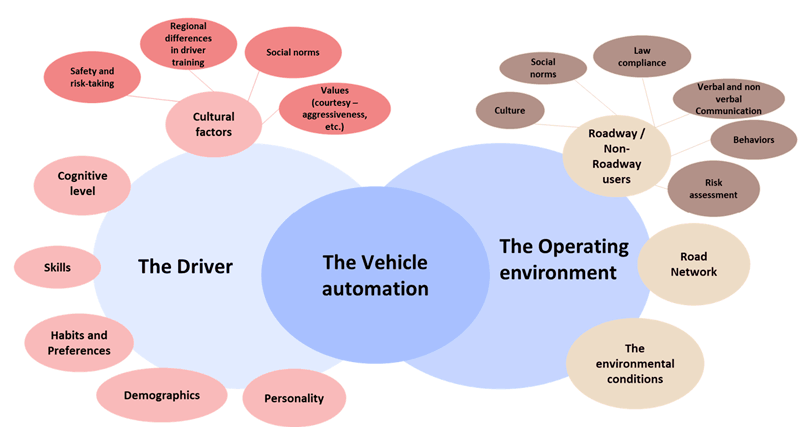by Javier Ibanez-Guzman, Imane Taourarti, Arunkumar Ramaswamy (Renault Group) and Ayesha Choudhary (Jawaharlal Nehru University)
This article explores how AI systems in autonomous vehicles perform differently across regions due to cultural, geographical, and socioeconomic factors embedded in their training data.
Modern vehicles increasingly rely on advanced driving assistance systems (ADAS) and autonomous functions, deploying AI-Enabled Systems (AIES) to enhance safety and passenger comfort. These systems have gained significant support worldwide, driven by legislation and evaluation programs like EuroNCAP, which promotes their adoption and enhance consumer confidence [L1]. These AIES systems, especially in the perception functions, rely heavily on data-driven methods. Machine learning (ML) models are trained using large datasets collected through extensive field campaigns, enabling detection, classification, and spatial understanding critical for decision-making. Rigorous testing follows to evaluate performance, focusing on metrics like false positives and false negatives for safety-critical functions such as pedestrian detection, lane departure warnings, and collision avoidance systems.
The behaviour of a vehicle reflects very much the context in which it evolves. The state of the road network, the complexity of the traffic sharing it (density, heterogeneity of vehicles, adherence to formal rules), the weather conditions affecting driving conditions (precipitation, visibility, temperature extremes), the quality of the infrastructure, etc. The different traffic agents with which it interacts, the presence of animals or debris, etc. As shown in Figure 1, we can state the traffic agents reflect other conditions like social norms, law compliance, the manner they communicate, the driving skill level / training, etc. An important factor is the notion of risk, this reflect the economic needs of the different traffic agents, safety valuations, and cultural attitudes of the different traffic agents. This short analysis provides an insight into how locality reflects vehicle behaviour that is captured when logging data used to derive the machine learning models found in ADAS or AD applications [1]. This granularity provides what we term the locality to data. As a result if the AD systems are trained in a given locality, which is substantial different to the one that it is to be deployed, for the systems to respond in the same manner will be challenging unless mechanisms are provided to address the bias that is reflected in the data.

Figure 1: Interconnection between Vehicle, driver, and operating environment with their contributing factors.
The main issue is that the ADAS and AD systems that incorporate functions that are derived from data their performance is significantly influenced by the datasets used for training [2]. These datasets often originate from specific regions, usually in northern hemisphere countries with distinct driving patterns, infrastructure, laws, and environmental conditions. In contrast, driving behaviours and road conditions in southern hemisphere countries, particularly in low- and middle-income regions, differ significantly due to ethnographic, legal, and geographical factors.
This geographical and cultural mismatch introduces biases in AI models, resulting in systems that may not perform effectively or safely when deployed in areas with differing local conditions. For example, a model trained on data from European roadways might struggle to adapt to the chaotic traffic patterns or poorly maintained infrastructure often found in other regions. The consequences of these biases can be severe, particularly in terms of safety outcomes, potentially reinforcing existing disparities in road safety between regions rather than mitigating them.
Addressing these biases is crucial to ensuring equitable and reliable road safety solutions worldwide. By incorporating diverse datasets that reflect local driving conditions, cultural norms, and behavioural patterns, automotive AIES can be better equipped to handle the complexities of global deployment. The development of culturally adaptive autonomous systems represents not merely a technical challenge but an ethical imperative to ensure that the benefits of advanced vehicle safety technologies are equitably distributed across diverse global populations.
Links:
[L1] https://www.euroncap.com/en/car-safety/safety-campaigns/2020-assisted-driving-tests
References:
[1] I. Taourarti et al., “Towards cross-cultural intelligent vehicles: A review,” in Proceedings of VEHICULAR 2023, The 12th Int. Conf. on Advances in Vehicular Systems, Technologies and Applications, 2023.
[2] V. Diviš, T. Schuster, and M. Hrúz, “Domain-centric ADAS datasets,” in SafeAI 2023: The AAAI’s Workshop on Artificial Intelligence Safety, 14 Jan. 2024.
Please contact:
Imane Taourarti
Research Department/Renault Group, France











